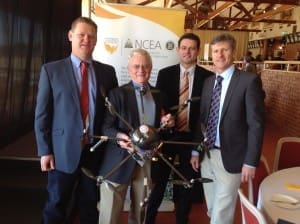
Rural Press Club of Queensland secretary Bernie Milford, Swarm Farm’s Andrew Bate, NCEA CEO Craig Baillie and RPCQ president Brendan Egan at the RPCQ AgShow breakfast in Toowoomba.
Picture this: It’s a crisp June morning on a mixed farming and cattle property in northern New South Wales.
In a field of wheat, a swarm of small, solar powered robots quietly moves in and around the crop, differentiating between green wheat plants and green weeds around them.
The robots systematically hit each weed with a precise and targeted dose of herbicide. (In future the next generation of these robots will actually blast each weed with a microwave, or physically pluck them from the ground, helping to overcome the serious problem of herbicide resistant weeds).
Buzzing overhead, an Unmanned Aerial Vehicle provides an “eye in the sky” for the operation, travelling across the farm at a rate of 250-500 hectares per hour.
It uses a camera and software to monitor the condition of each hectare of crop and pasture, information that is combined with the data from a network of electronic sensors to identify emerging “hot spots” before they become serious problems.
The information is fed directly into a heads-up display the farmer sees while working in a tractor three paddocks away. This ‘augmented reality’ ensures he can intervene early to counter emerging issues before they become serious problems, and can concentrate on the task in front of him, secure in the knowledge he will be informed of any pressing developments as soon as they are identified.
Elsewhere on the farm, a fully-automated adaptive-control irrigation system is delivering significant water savings and yield increases. The new state of the art centre-pivot irrigation system is a great example of adaptive, variable rate systems that can “see, think and do”: Sensors and decision support tools allow the centre pivot to deliver precisely the amount of water that each section of the field requires, reducing water wastage and optimising crop yields.
On the livestock side of the operation, machine vision technology fitted to the side of a cattle-handling race automatically assesses and records the condition score of every animal that passes through, information that is used to control an automatic drafting system further on.
Another automatic drafting system around a watering point in a distant paddock is being used to separate feral animals from the herd. In the past week the system has drafted off a truck load of feral goats which can now be sold to an abattoir and will deliver about $10,000 in value to the operation.
The above scenario is just a small glimpse of how rapidly emerging robot and automation technology is set to shape farms of the not-very-distant future.
It combines just some of the fascinating insights provided by two pioneers of automated technology in agriculture to a large Rural Press Club of Queensland breakfast at the AgShow field days in Toowoomba last week.
Craig Baillie is the chief executive officer of the National Centre for Engineering in Agriculture at Toowoomba’s University of Southern Queensland, and Andrew Bate is an Emerald-district farmer who is also pioneering the introduction of robotic technology in agriculture via his “Swarm Farm” business.
Both left the audience in little doubt that robots and other automation technology will increasingly be appearing in practical applications on farms sooner rather than later.
They also helped to dispel the view that robotic technology is just and only about saving labour on farms.
Rather, and more importantly, robotics and digital automation technology is about enhancing the running of the overall farm, and levering more potential from crops, pasture and genetics, while also delivering better environmental outcomes.
Craig Baillie said the NCEA’s research is focused primarily on merging precision agriculture with automation technology to deliver the next transformative change in agriculture.
It is about integrating sensors, decision support tools and, automation and control systems into intelligent, adaptive machines that can “see, think and do”.
“Automation technologies will assist farmers by more precisely varying the amount of herbicide, fertiliser or water that is applied to the farm,” Mr Baillie said.
“these technologies are about trying to ‘nail it’ every time”
“The end result is that the right management strategy can be implemented at the right place at the right time, but more importantly every time.
“As producers you are probably aware yourself that there are times that you really nail the management of your production in your cropping system, these technologies are about trying to ‘nail it’ every time.”
Andrew Bate told the audience that the technology that has pushed agriculture for the past 20 years was plateauing.
In that time the size of his machinery had increased in horsepower, size and weight by a factor of three.
‘We’ve been dining out on a fast food boom, but that sugar high is starting to end’
With bigger machines had come slowing productivity gains versus rising costs, greater compaction of soils and weeds that were increasingly resistant to herbicides, a problem now costing the grains industry more than $200m a year.
Everyone was just looking for more horsepower under the bonnet, Mr Bate said, but could not keeping going down that path.
Agriculture had been dining out on a kind of a fast food boom but that sugar high was starting to end, he said.
Small, simple machines that do simple tasks very well
In Mr Bate’s view the solution lies in using swarms of “small, simple machines that do simple tasks very well”.
At the moment Mr Bate uses a 36m wide, 21 tonne high clearance spray rig to spray his crops, which passes over about 28,000 individual plants every second.
He says in future that job will be done by a small number of robotic devices, each weighing a couple of hundred kilos, operating at individual plant level, 24 hours a day, seven days a week.
“I truly believe the benefits of robotics are going to be higher yields, better efficiency of farming and better environmental outcomes,” Mr Bate said.
He said better farming outcomes would be achieved in future by “slowing everything down” and returning to the days, albeit via new technology such as robots, when plants were managed at individual plant level.
Small robots give every farmer access to latest technology
Scalability was another benefit. Small simple machines could be scaled to suit any operation. At present the price of entry for most modern farm machinery was hundreds of thousands of dollars, which put the latest technology out of reach of most farmers.
“With the swarming concept, everyone can access the latest technology. A small farmer in the third world might own one of these machines, a large farmer in northern NSW might own 36 of them,” Mr Bate said.
“But all of them have affordable access to the latest technology and that is a big change.
“A farmer that is expanding by buying more land can simply increase his productivity by employing an extra machine.”




HAVE YOUR SAY